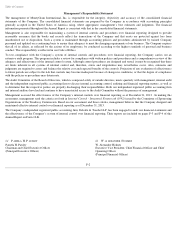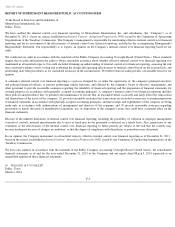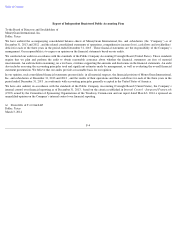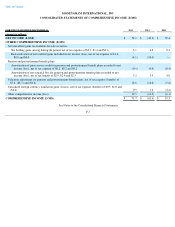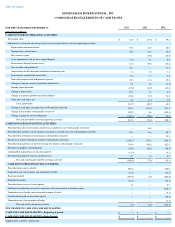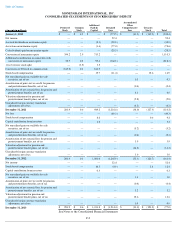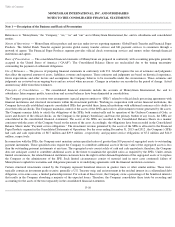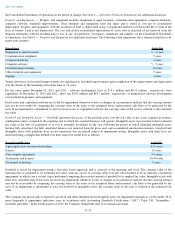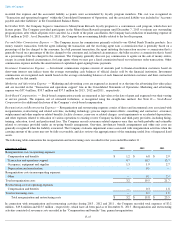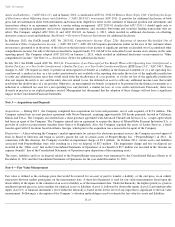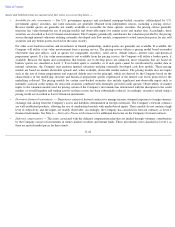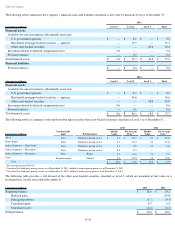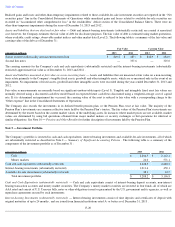MoneyGram 2013 Annual Report Download - page 79
Download and view the complete annual report
Please find page 79 of the 2013 MoneyGram annual report below. You can navigate through the pages in the report by either clicking on the pages listed below, or by using the keyword search tool below to find specific information within the annual report.
Table of Contents
Note 2 — Summary of Significant Accounting Policies
Substantially Restricted — The Company’s licensed entity MoneyGram Payment Systems, Inc. (“MPSI”)
is regulated by various U.S. state
agencies that generally require the Company to maintain a pool of assets with an investment rating of A or higher (“permissible investments”)
in
an amount equal to the payment service obligations, as defined by each state, for those regulated payment instruments, namely teller checks,
agent checks, money orders and money transfers. The regulatory payment service assets measure varies by state, but in all cases excludes
investments rated below A-.
The most restrictive states may also exclude assets held at banks that do not belong to a national insurance program,
varying amounts of accounts receivable balances and/or assets held in one of the SPEs. The regulatory payment service obligations measure
varies by state, but in all cases is substantially lower than the Company’
s payment service obligations as disclosed in the Consolidated Balance
Sheets as the Company is not regulated by state agencies for payment service obligations resulting from outstanding cashier’
s checks or for
amounts payable to agents and brokers.
In connection with the SPEs, the Company also has certain financial covenants that require it to maintain pre-
defined ratios of certain assets to
payment service obligations. The financial covenants under the credit agreement are described in Note 9 — Debt.
Financial covenants related to
the SPEs include the maintenance of specified ratios of cash, cash equivalents and investments held in the SPE to the outstanding payment
instruments issued by the related financial institution customer.
The regulatory and contractual requirements do not require the Company to specify individual assets held to meet its payment service
obligations, nor is the Company required to deposit specific assets into a trust, escrow or other special account. Rather, the Company must
maintain a pool of liquid assets sufficient to comply with the requirements. No third party places limitations, legal or otherwise, on the Company
regarding the use of its individual liquid assets. The Company is able to withdraw, deposit or sell its individual liquid assets at will, with no prior
notice or penalty, provided the Company maintains a total pool of liquid assets sufficient to meet the regulatory and contractual requirements.
The Company is not regulated by state agencies for payment service obligations resulting from outstanding cashier’
s checks; however, the
Company restricts a portion of the funds related to these payment instruments due to contractual arrangements and Company policy. Assets
restricted for regulatory or contractual reasons are not available to satisfy working capital or other financing requirements. Consequently, the
Company considers a significant amount of cash and cash equivalents, receivables and investments to be restricted to satisfy the liability to pay
the principal amount of regulated payment service obligations upon presentment. Cash and cash equivalents, receivables and investments
exceeding payment service obligations are generally available; however, management considers a portion of these amounts as providing
additional assurance that business needs and regulatory requirements are maintained during the normal fluctuations in the value of the
Company’
s payment service assets and obligations. The following table summarizes the amount of assets in excess of payment service
obligations as of December 31 :
Regulatory requirements also require MPSI to maintain positive net worth, with certain states requiring that MPSI maintain positive tangible net
worth. The Company was in compliance with its contractual and financial regulatory requirements as of December 31, 2013 .
Cash and Cash Equivalents (substantially restricted) —
The Company defines cash and cash equivalents as cash on hand and all highly liquid
debt instruments with original maturities of three months or less at the purchase date.
Receivables, net (substantially restricted)
—
The Company has receivables due from financial institutions and agents for payment instruments
sold and amounts advanced by the Company to certain agents for operational and local regulatory compliance purposes. These receivables are
outstanding from the day of the sale of the payment instrument until the financial institution or agent remits the funds to the Company. The
Company provides an allowance for the portion of the receivable estimated to become uncollectible as determined based on known delinquent
accounts and historical trends. Receivables are generally considered past due one day
after the contractual remittance schedule, which is
typically one to three days after the sale of the underlying payment instrument. Receivables are evaluated for collectability by examining the
facts and circumstances surrounding each customer when an account
F-11
(Amounts in millions) 2013
2012
Cash and cash equivalents (substantially restricted)
$
2,228.5
$
2,683.2
Receivables, net (substantially restricted)
767.7
1,206.5
Interest-bearing investments (substantially restricted)
1,011.6
450.1
Available-for-sale investments (substantially restricted)
48.1
63.5
4,055.9
4,403.3
Payment service obligations
(3,737.1
)
(4,175.4
)
Assets in excess of payment service obligations
$
318.8
$
227.9


